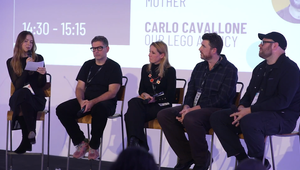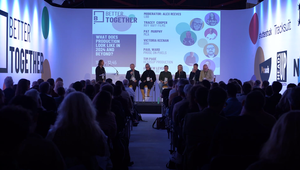
“It’s Got a Bit Wild West at the Moment”: Production Leaders on the Landscape Today

Andrew Levene was in agreement with his fellow panellists that when it comes to production “there’s room for everyone,” speaking at LBB’s Better Together summit last week. But the Stink Films managing director did add, “I think it's got a bit wild west at the moment.”
Attributing the fractured landscape of production processes to the rapid changes in technology and media, he noted “that's great because it's very exciting, but probably we need to work out some rules between us so that we can all work together, get there and can still make great work. I'm not saying I know what those rules are.”
That comment was representative of a surprisingly collegiate and positive panel discussion called ‘What Does Production Look Like in 2024 and Beyond?’ between production experts including consultants, production company leaders, an agency producer and the head of an agency-owned content studio. LBB’s CEO Matt Cooper had reminded Better Together attendees to ‘play nice’ and this message had clearly sunk in with the panellists, despite the tensions between independent production companies and agencies’ in-house production that have recently been running high.
What In-House Production Is For
Paul Ward, president of the global network and UK CEO at Prose on Pixels (which is part of Havas and has banned the word ‘in-house’), addressed that atmosphere head on. “I certainly don't wake up in the morning and think, ‘How can I screw everybody in this room?’” he said. “It feels a bit like this industry at the minute is a bit like the discos I used to go to when I was a kid. There's somebody in the corner really wanting to pick a fight with you, really angry, and you don't know why, and so what you end up doing is staying away from that corner. What we want to try and do is work out how we can get in that corner and make friends and understand what we've got in common.”
Indeed, Victoria Keenan, head of production at creative agency BBH London, dispelled the misconception that BBH wants to produce everything in house. “Straight forward, we don't want to,” she said. “There is a layer of work that works to produce in house, because we have these internal makers or creators that can jump on the back of bigger TVC shoots or out of home shoots. We do want to work with external production partners.”
As do all the best brand clients, she noted, having listened to the panel earlier that morning where marketers expressed their admiration and trust for the best directors and photographers. “They want their agencies to suggest and recommend the best talent for the work. And that is what all of the producers in the department like,” enthused Victoria. “That's the best bit, trying to elevate the idea in the best way possible.”
Finding Your Groove
Specialisation and understanding what part of the production puzzle your company does best was a theme that the panel circled around throughout the hour-long discussion. Tracey Cooper, executive producer at Riff Raff, discussed how the production company had “kept an open mind about where the market is going, remained realistic with ourselves. Sticking to what we know best might sound old fashioned, but it’s what we do,” she said.
Stink has always had a culture of remaining “ahead of the game,” noted Andrew, not wanting to rule out the ‘smaller’ work that some might not bring to the internationally renowned company. “If the idea is good we want to do it and it doesn’t matter how small or big it is – if it’s good, we’d like to be involved. It’s a mix of specialising and diversifying, but there is a balance in there.”
Knowing the right production specialist is exactly what agency production departments like Victoria’s are built for. She explained how BBH splits the production department by disciplines.
Building Connection and Transparency
While good agency production departments like Victoria’s do that, Tim Page, partner and producer at Heads Up Production knows that brands want to be closer to the makers of their content. As a former head of production, he and his co-founders set up their consultancy seven years ago with the mantra “to bring production and brands closer together. It’s the trust aspect that is really important,” he said.
Tim pointed to the APA report which was published recently, which he said indicated that “a lot of brands feel like they don't quite know what's going on in the production or the production marketplace.” That’s what companies like Heads Up are trying to remedy, he said.
Pat Murphy, founder and CEO of MCA pointed to the way that the complex production landscape leads to wastefulness. “The production of the content is one part of an asset’s life cycle,” he said. “We try to optimise that part of the cycle in the best possible way. 60-70% of all assets that get created don’t ever get used.”
He added, somewhat provocatively to a room with many producers in it that, “the best way to do sustainable production is to not produce anything at all. It’s about shooting only what you actually need and then leveraging that work.”
The Future of Talent
The conversation turned to the talent that’s needed to populate a healthy, future-facing production industry and even the two production companies who are known for doing the most ‘high-end’ or ‘traditional’ TV ads noted the change in creative talent they’re working with. Social-native creators don’t do social work to get to the traditional work, said Tracey. “Their career path isn't, ‘we do that to get to the films’. They're becoming excellent in their field. Before you would do some social so that you could get noticed, get your reel together, be doing the big films. Now they have a skill set of their own, and there's a whole career path within that sector,” she said.
Andrew added that “there's been an explosion of creativity because of the opportunities in social media,” and much of that talent will have work going forward. But the directors who do still aspire to helming high-end commercials are the ones finding it challenging. “If I look back at the last year's worth of work, I could probably pick 20 directors that have done 80% of it,” he said, “and they're all ‘grown ups’, for want of a better word, who’ve been doing it for a significant amount of time and have a very large back catalogue. The opportunities for the younger people is the challenge – how do you get them the opportunities?”
One the more tech-led and digital end of things at Prose on Pixels, Paul sees two kinds of makers: “Those that do not want to use new platforms and those who don’t understand why not. That’s the big change, the new people coming in use these platforms all day every day to make them better. But the older guys are still trying to wrap their heads around it.”
Tomorrow’s Production World
It’s always a risk to make predictions, especially about the future, as the adage goes, but the panel attempted to cast their minds forward to a future production industry to round off the panel.
For Pat, two broad principles would define the companies that have longevity: “The ones that are agile and learning about deploying technology in the best way.” Secondly, the ones that are “listening to clients and what's changing.”
Tim’s future is one of defined specialisation. “There's going to be a multitude of companies in their various guises, from the big network companies who are putting everything under one roof through to [...] smaller creative studio type approaches that do the creative, the production and everything all the way through. I think there'll be specialists in the kind of production that won't necessarily just have traditional, brilliant filmmakers. There'll be AI artists, technologists and VR developers.”
As the head of a production company, Andrew predicted that the future will realistically see fewer production companies. “Bigger players will still be there because of good talent,” he said, alongside “smaller, more specialised companies doing specific work that are incredibly good at it. There are too many directors now, so they will reduce.”
But as some disciplines fall in demand, others will rise. Victoria noted that production company The Sweetshop has just launched a roster of AI artists. “I think it's really interesting because there's so much creativity there. A lot of the creatives at BBH are looking to AI a lot and I think that that's definitely an area that will be interesting to see how it evolves.”
The way brands speak about production is changing. “When I started in production, we never talked about assets,” said Paul, noting that clients earlier that day had spoken a lot about ‘assets’ and covering the many places they can end up when planning production. He also noted that gen AI is starting to enter into creation of said assets. “We've either got to get really angry about it, or try and build a business that can address it. And I think the ones that build the businesses that address it are the ones that are going to flourish.”
A big thanks to our sponsors
Shutterstock | Park Village | Peach | NaF | Heads Up Production | Tracksuit
















